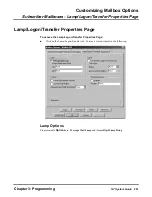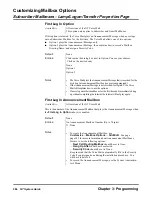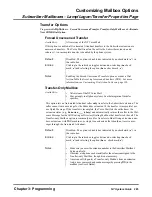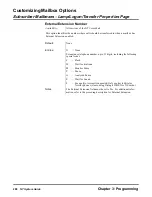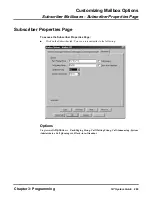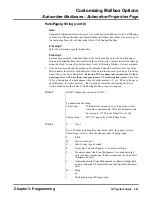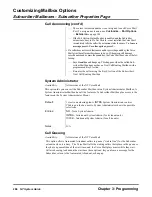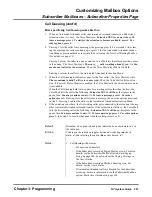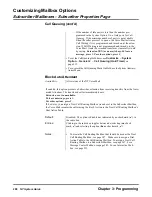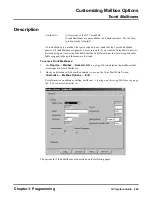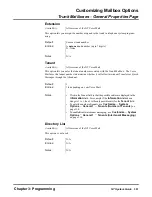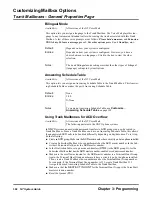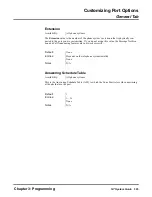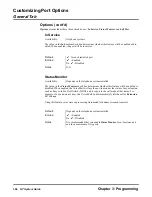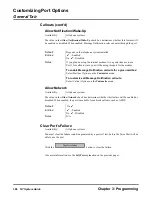
Customizing Mailbox Options
Subscriber Mailboxes - Subscriber Properties Page
294
NT System Guide
Chapter 3: Programming
Call Waiting String (cont’d)
Call Announcing
This option lets the Voice Mail announce an Automated Attendant caller to the Subscriber exten-
sion. The Subscriber can then accept or reject the call. There are three Call Announcing options.
Option 1
1.
When a caller tries to make a screened transfer to the Subscriber extension, the Voice Mail
says: At the tone, please record your name so that I may announce your call. When you
are done recording, press the pound key.
2.
When the caller presses the pound key, the Voice Mail tries the extension. If the caller does
not press the pound key within a certain amount of time, the Automated Attendant trans-
fers the call anyway. (The time interval is the Time limit for dialing commands for the Call
Routing Mailbox handling the call.)
3.
When the Subscriber answers and says Hello, the Voice Mail says this: Hello. I have a
call for (Subscriber's extension XXX or name) from (the caller's recorded name). To
accept this call, press 1. Otherwise, hang up.
4.
If the Subscriber dials 1, the Voice Mail says, Connecting, then connects the parties. If the
Subscriber hangs up, the caller hears the Subscriber's mailbox greeting (if recorded) or
these voice prompts: Extension XXX (or name) is not available. To leave a message,
press 1. For other options, press 2.
If the greeting plays, a caller can leave a message, then hang up, press # for the Automated
Attendant, or re-route their call according to the options in the Next Call Routing Mailbox (for
details, see page 131.
If the extension status message plays, the caller can press 1 to leave a message or 2 to return to
the Automated Attendant Instruction Menu. After leaving a message, the caller can hang up,
press # for the Automated Attendant Instruction Menu, or press a code to re-route their call
according to the options in the Subscriber's Next Call Routing Mailbox (for details, see
Screened Transfer to an Extension on page 131.)
— If Call Queuing is enabled and the minimum number of idle
ports for Call Queuing is available. Call Queuing overrides Call
Waiting.
• The number of callers that can wait for the same extension is determined
by the telephone system.
• To set the Flash timer (if Park/Paging string requires a Flash), the Meet-Me
Page hold timer, and the Hang-up timer, use
Customize
¿
System Options
¿
Timers
. (See page 332.)
• If a busy Subscriber would rather be paged instead of receive Call Waiting
beeps, you can enter the Park/Paging string in the Call Waiting string field.
The Subscriber must still turn on Call Waiting at their phone. This gives a
caller the option to page the busy Subscriber, not send beeps. For more
information, see the Subscriber Mailbox option, Park/Paging String on
page 290.
Availability:
All versions of the NT Voice Mail.
Options 1 and 2 apply to the VS/DS01/DS100
Option 1 is available to all other phone systems.
Option 3 applies only to the ONYX phone systems..
Summary of Contents for NVM-NT
Page 28: ...Table of Contents Chapter 5 Maintenance xxvi NT System Guide ...
Page 130: ...Installing SMDI 102 NT System Guide Chapter 3 Programming ...
Page 146: ...Customizing Caller I D Tables General Tab 118 NT System Guide Chapter 3 Programming ...
Page 156: ...Customizing Callout Options Optional Tab 128 NT System Guide Chapter 3 Programming ...
Page 182: ...Customizing Distribution Lists General Tab 154 NT System Guide Chapter 3 Programming ...
Page 338: ...Customizing Port Options General Tab 310 NT System Guide Chapter 3 Programming ...
Page 358: ...Customizing System Options Timers Tab 330 NT System Guide Chapter 3 Programming ...
Page 362: ...Customizing System Options Timers Tab 334 NT System Guide Chapter 3 Programming ...
Page 367: ...Customizing Tenant Options General Tab Chapter 3 Programming NT System Guide 339 ...
Page 396: ...Viewing and Printing Reports System Options Report 368 NT System Guide Chapter 3 Programming ...
Page 400: ...Performing a Local Backup Backup Dialog Box 372 NT System Guide Chapter 3 Programming ...
Page 440: ...Using Port Activities 412 NT System Guide Chapter 3 Programming ...
Page 454: ...Using Message Status Message Status Dialog Box 426 NT System Guide Chapter 3 Programming ...


